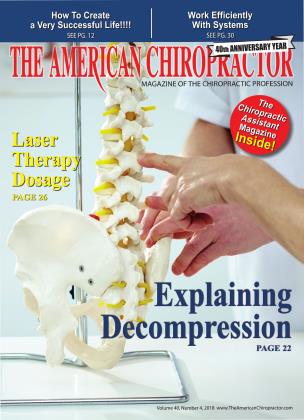An Active Workspace: How to Control Back Pain Outside of Your Chiropractic Sessions
INNOVATION
Jason McCann
When my colleague, Dan Flaherty, was diagnosed with sciatic nerve pain, his physical therapist suggested he alternate between sitting and standing at work. The options available at the time were limited to a cardboard box or a complicated and expensive standing desk.
As a serial entrepreneur, Dan knew we could do better. Not just for him, but for everyone who suffered from back pain due to chronic sitting. Together with Dan and our head industrial designer, we got to work sketching what would become the first VARIDESK — a convenient, easy-to-use height-adjustable solution.
Except for athletes and physical laborers, most people today work in offices that require them to sit for extended periods. Among the many health risks sitting poses, lower back pain is one of the most prevalent. It’s also one of the top causes of work disability, and treating it is a more than $50 billion industry.1
In addition to chiropractic treatment and regular exercise, preventing or treating back pain should include incorporating more movement in the workplace. Because thinking about health as an "outside the office" issue overlooks the fact that the place Americans spend most of their adult lives — the office — should be designed with health in mind.
What a Sedentary Lifestyle Costs
Whether watching TV, driving, or working, the average American adult spends nearly half their life in a sedentary position.2 In addition to back pain, people who aren't active throughout the day are at a higher risk of serious and chronic health issues, including cardiovascular disease and depression, and they suffer higher mortality rates.3
These health issues also impact a company's productivity. In fact, it’s estimated that health issues cost up to $153 billion in lost productivity each year.4 Sick leave associated with back pain alone accounts for almost $86
"The options available at the time were limited to a cardboard box or a complicated and expensive standing desk."
billion of that impact.5 And for smalland mid-sized companies with a smaller workforce who often perform more roles, that loss is even more pronounced.
The good news is that this cycle can be stopped by implementing a few, daily changes and being more active in the office.
Tips for your Patients Dealing with Chronic Back Pain
From the beginning, we’ve heard from customers that use our products to help relieve their back pain. Their immobility at work was only making their pain worse, and they needed the option to get up and get moving.
Small strategies like this, along with switching to walking meetings and moving office equipment to central locations, create opportunities for movement. Of course, there’s always room for more. Whether for runners, bikers, or more leisurely walk-takers, we’ve heard firsthand how an active workspace can complement an employee’s active lifestyle and help keep them healthy.
In conjunction with your expert chiropractic care, patients dealing with back pain should consider ways to be more active at work, every day. We should all be moving toward an active workspace, an environment where movement, flexibility, and simplicity come together to create an office that is healthier, happier, and more productive for everyone.
From the beginning, we’ve heard from customers that use our products to help relieve their back pain. 5 5
Why Everyone Benefits from an Active Workspace
An active workspace can be as simple as implementing a sit-stand solution for your desk, which encourages you to move around more while you work. Not only does a standing desk compress your spine less than sitting,6 it also works your core, which can help you burn up to 650 calories per week.7 More holistically, an active workspace combines functional enhancements, such as dynamic furnishings, with cultural enhancements, such as fostering collaboration by encouraging movement, that energize an office and its workers to promote a greater, overall sense of well-being.
As you feel better both mentally and physically, you’ll regain your creativity and ability to perform. Improved circulation helps improve mental clarity, and the elimination of back pain drastically reduces other health issues
and the need for sick leave. A comparative study between seated desk users and stand-capable desk users in 2015 showed that employees who stood were up to 45 percent more productive than their sitting counterparts.8
While health and wellness programs have long been integrated into many companies, people are increasingly more aware of the impact that poor health has on their lives and on business success. Back pain can be debilitating, not to mention detrimental to your overall health as it prevents movement and promotes sedentary behavior. But chiropractors and patients who understand the resources at their disposal — and the myriad benefits that an active workspace offers — can stop living to get out of the office and address their health concerns right where they work.
References
1. The #1 Reason People Call in Sick; Prevention.com
2. Ergotron ⅛ JustStand Index; 2013
3. Sitting time and mortality from all causes, cardiovascular disease, and cancer; Medicine & Science in Sports & Exercise
4. Unhealthy U.S. Workers'Absenteeism Costs $153Billion; Gallup.com. Galluplnc., 17 Oct. 2011. Web. 13 Sept. 2016.
5. http.VAvww. spineuniverse. com/conditions back-pain low-back-pain
6. Back Care and Standing Work; SpineUniverse.com
7. Difference in caloric expenditure in sitting versus standing desks; Journal of Physical Activity and Health.
8. Call Center Productivity Over 6Months Following a Standing Desk Intervention; Journal HE Transactions on Occupational Ergonomics and Human Factors.
A lifelong entrepreneur, Jason McCann has over 20 years of experience building and running successful companies. As a founder and the CEO ofVARIDESK, Jason's mission is to help companies reimagine the workspace. VARIDESK started with one innovative product and has grown to be a global leader in workspace innovation with products sold in over 130 countries.
 View Full Issue
View Full Issue






